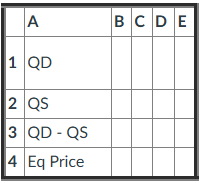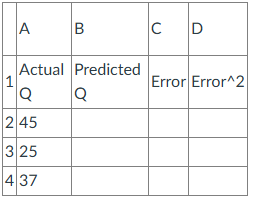AGBM 106 - Exam 1 Canvas Quizzes
1/39
There's no tags or description
Looks like no tags are added yet.
Name | Mastery | Learn | Test | Matching | Spaced |
|---|
No study sessions yet.
40 Terms
All other things being equal consumers prefer lower prices
True
(Assume P is on vertical axis and Q on horizontal axis)
Supply is downward sloping in price
False
Assume the price of apples right now is $5.00/bushel. At that price demanders demand 20 bu but suppliers are only supplying 10 bu. For the market to reach equilibrium, the price of apples must go down.
False
When is it appropriate to share files with other students?
Never (unless given permission by the instructor)
I would like to use the number stored in cell B1. This number will not change. I intend to copy and paste this formula into different rows. I will not paste into different columns. When I refer to B1, I should use?
B$1
The demand for tomatoes is fixed at 100 units. The supply of tomatoes is given by tomato quantity supplied = 20 + 4*P. What is the equilibrium price?
Hint: the equation is 100 = 20 +4P. Solve for P.
$20
The demand for pigs ears is Qd = 10 - P. The supply for pigs ears is Qs = 2 + P. What is the equilibrium price for pig’s ears?
Hint: Set Qd equal to Qs and solve for P.
$4
I have a number stored in cell A1. This number is fixed and never changes. I will use the number in A1 in a formula that will get copied into different columns and different rows. How should I refer to cell A1 in my formula?
$A$1
The demand for frog legs is given by Qd = 4 - P while the supply of frog legs is given by Qs = 1 + 3P. What is the equilibrium price of frog legs?
$0.75
Demand is upward sloping in price.
False

Ned is trying to determine the equilibrium price of corn using goal seek. Ned has the necessary supply and demand formulas to do so. Looking at the mock spreadsheet below, what cell should be the “set cell”?
Hint: This will always be QD - QS
B3
What is the mode of 0,9,-9,0,4?
This is the number that occurs most frequently in the set
0
Calculate the median of -7,0,5,7,-5.
Put the numbers in order and see what the middle number is
0
The demand for frog legs is QD = 5 - 0.5*PFrog Legs - 0.1*Income. The supply of frog legs is QS = 0 +1.5*PFrog Legs. Assume income is $10. What is the equilibrium price of frog legs?
$2
Assume potatoes are a complement to turkey. If the price of potatoes goes down then the equilibrium price of turkey price will decrease.
False
Assume peaches are a substitute for nectarines. If the price of peaches goes down then we would expect the equilibrium price for nectarines to decrease.
True
Calculate the average of -5,0,5,7,-7.
0
Income is positively related to quantity demanded for all agricultural products.
False
The demand for peaches is estimated to be QD = 10 - 2*P of Peaches + 0.5*I. If the price of peaches is $1.00 and income is $10, then peach demand quantity is:
13
The demand for grapes is estimated to be QD = 100 - 5*P of Grapes + 2.2*P Good x. Which of the following best describes the relationship between grapes and good x?
Substitutes
The actual demand for butter in 1987 was 100 lbs per person per year when the price of butter was $1.00 per lb (data made up). A butter demand regression model has been estimated and the model predicts butter demand of 110 lbs at a price of $1.00 per lb. What is the squared error for this observation?
Hint: Subtract the difference of the two lb demands and square the answer
100
Of the tasks listed below, which one is Excel solver unable to complete?
Milk a cow
A regression model can be used to calculate?
Conditional averages
Predicted egg demand is estimated to be:
QD = 100 - 2*PEgg - 0.5*PBacon
According to this model, which of the following statements is true?
Bacon is a complement to eggs
In a regression model we seek the intercept and slope that maximize the sum of squared errors.
False
Two different regression models have been estimated. In both cases the y variable was the same prune demand. Model 1 was prune price as the x variable to explain prune demand and has a SSE of 10. Model 2 used consumer income as the x variable to explain prune demand and had a SSE of 5. Which model best explains prune demand?
Model 2
Egg demand is estimated to be:
QD = 50 - 0.5*PEgg
What egg demand would we expect if PEgg is $2.00?
49

Looking at the following spreadsheet:
If a regression is being estimated using solver which cell should be the “set objective”?
Hint: This is always the SSE cell
B1
Historical data is used to estimate a regression for peach demand, peach quantity is measured in bushels and peach prices are measured in $ per bushel. The regression model estimated is QD = 17 - 2.5*PPeach. The overall historical average for the PPeach is $2.00. What is the overall historical average for quantity of peaches demanded?
12

Looking at the spreadsheet:
What formula should be in cell C2?
A2 - B2
Asparagus total variable cost is given by TVC = 10q² - q. What is the total variable cost of producing 5 units of asparagus?
$245
Asparagus total variable cost is given by TVC = 10q² - q. What is the average variable cost of producing 2 units of asparagus?
Hint: Find the TVC, then subtract the quantity from that answer and divide by the quantity
$19
What should a firm do is AVC > P?
Produce nothing
What is the formula for gross margin?
P - AVC
What is the formula for profit margin?
P - ATC
Profit is always greater than or equal to 0?
False
A monopolist knows it can sell as much output as it can produce.
False
Firm 1 is a hog farm that produces lean hogs. Firm 2 is a pork packing firm that has its own brand of pork sausage. Which firm is in a market that is closer to bein monopolistic?
Firm 2
It costs a firm $200 to produce 10 units of product. What is ATC at this production level?
Hint: ATC = P/Q
$20
A firm in a perfectly competitive market has chosen the optimal level of production:
q = 5
ATC = $10
Price (per unit of q) = $12
What is the firm’s profit?
Hint: First find TR = P x q, then TC = ATC x q, then Profit = TR - TC
$10